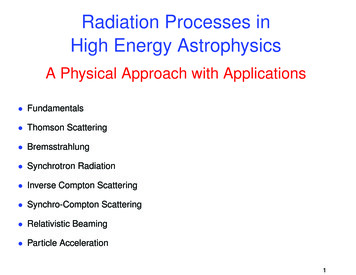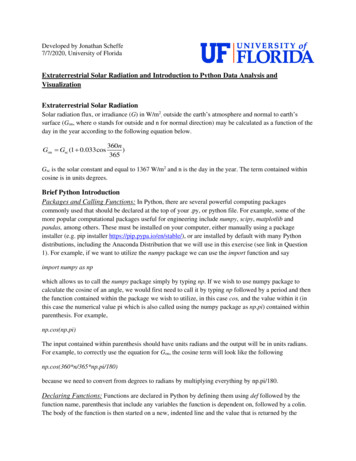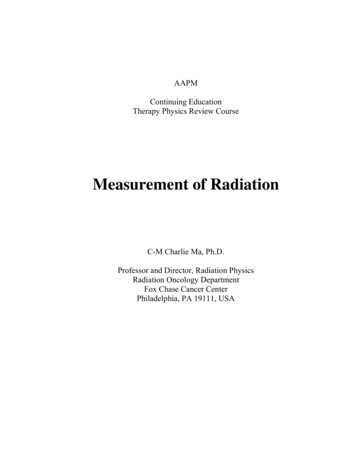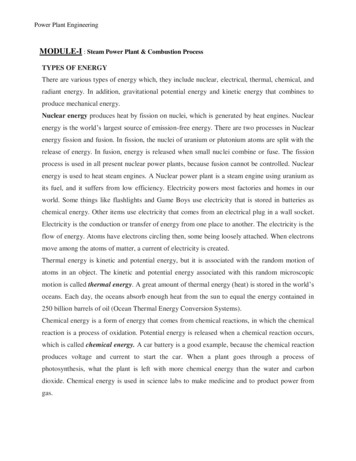
Transcription
Radiation Processes inHigh Energy AstrophysicsA Physical Approach with Applications Fundamentals Thomson Scattering Bremsstrahlung Synchrotron Radiation Inverse Compton Scattering Synchro-Compton Scattering Relativistic Beaming Particle Acceleration1
High Energy AstrophysicsBooks1997 edition (HEA1)1997 edition (HEA2)20062
Basic Radiation ConceptsMuch of what we need to understand radiation processes in X-ray and γ-rayastronomy can be derived using classical electrodynamics and central to thatdevelopment is the physics of the radiation of accelerated charged particles. Thecentral relation is the radiation loss rate of an accelerated charged particle in thenon-relativistic limitdE p̈ 2q 2 r̈ 2 (1) .dt rad6πε0c36πε0c3p q r is the dipole moment of the accelerated electron with respect to some origin.This formula is very closely related to the radiation rate of a dipole radio antennaand so is often referred to as the radiation loss rate for dipole radiation. Note that Iwill use SI units in all the derivations, although it will be necessary to convert theresults into the conventional units used in X-ray and γ-ray astronomy when they areconfronted with observations. Thus, I will normally use metres, kilograms, teslas andso on. 3
The radiation of an accelerated charged particleJ.J. Thomson’s treatment (1906, 1907)Consider a charge q stationary at the origin O ofsome inertial frame of reference S at time t 0.The charge then suffers a small acceleration tovelocity v in the short time interval t. After atime t, we can distinguish between the fieldconfiguration inside and outside a sphere ofradius r ct centred on the origin of S. Outsidethis sphere, the field lines do not yet know thatthe charge has moved away from the origin andso the field lines are radial, centred on O. Insidethis sphere, the field lines are radial about theorigin of the frame of reference centred on themoving charge. Between these two regions,there is a thin shell of thickness c t in whichwe join up corresponding electric field lines.4
Radiation of anaccelerated chargedparticle (2)There must be a component of the electric fieldin the iθ direction. This ‘pulse’ ofelectromagnetic field is propagated away fromthe charge at the speed of light and is theenergy loss of the accelerated charged particle.The increment in velocity v is very small, v c, and therefore it can be assumed thatthe field lines are radial at t 0 and also attime t in the frame of reference S.Consider a small cone of electric field lines atangle θ with respect to the acceleration vector ofthe charge at t 0 and at some later time twhen the charge is moving at a constant velocity v. We join up electric field lines through thethin shell of thickness c dt as shown in thediagram.5
The radiation of an accelerated charged particle (3)The strength of the Eθ component of the field is given by number of field lines perunit area in the iθ direction. From the geometry of the diagram, the Eθ fieldcomponent is given by the relative sizes of the sides of the rectangle ABCD, that is(2)Eθ /Er v t sin θ/c t.Er is given by Coulomb’s law,Er q/4πε0r 2(3)where r ct,and soq( v/ t) sin θEθ .4πε0c2r(4) v/ t is the acceleration r̈ of the charge and henceEθ qr̈ sin θ.24πε0c r(5)6
The radiation of an accelerated charged particle (4)Notice that the radial component of the field decreases as r 2, according toCoulomb’s law, but the field in the pulse decreases only as r 1 because the fieldlines become more and more stretched in the Eθ -direction, as can be seen from (2).Alternatively we can write p qr, where p is the dipole moment of the charge withrespect to some origin, and henceEθ p̈ sin θ.24πε0c r(6)This is a pulse of electromagnetic radiation and hence the energy flow per unit areaper second at distance r is given by the Poynting vector E H E 2/Z0, whereZ0 (µ0/ε0)1/2 is the impedance of free space. The rate loss of energy throughthe solid angle dΩ at distance r from the charge is therefore p̈ 2 sin2 θdE p̈ 2 sin2 θ2 dΩ r dΩ dΩ.223242dt rad16π ε0c16π Z0ε0c r (7)7
The radiation of an accelerated charged particle (5)To find the total radiation rate, we integrate over all solid angles, that is, we integrateover θ with respect to the direction of the acceleration. Integrating over solid anglemeans integrating over dΩ 2π sin θ dθ and soπ p̈ 2 sin2 θdE 2π sin θ dθ.dt rad0 16π 2 ε0 c3We find the key result Z(8)dE p̈ 2q 2 r̈ 2 .dt rad6πε0c36πε0c3 (9)This result is sometimes called Larmor’s formula – precisely the same result comesout of the full theory. These formulae embody the three essential properties of theradiation of an accelerated charged particle.8
The Properties of Dipole RadiationdEq 2 r̈ 2 .3dt rad6πε0c 1. The total radiation rate is given by Larmor’s formula.The acceleration is the proper acceleration of theparticle and the loss rate is measured in itsinstantaneous rest frame.2. The polar diagram of the radiation is of dipolar form,that is, the electric field strength varies as sin θ andthe power radiated per unit solid angle varies assin2 θ, where θ is the angle with respect to theacceleration vector of the particle. Notice that thereis no radiation along the acceleration vector and thefield strength is greatest at right angles to theacceleration vector.3. The radiation is polarised with the electric fieldvector lying in the direction of the accelerationvector of the particle, as projected onto a sphere atdistance r from the charged particle.9
Radiation of Accelerated ElectronImproved VersionSee High Energy Astrophysics, Volume 1, for details. Write down Maxwell’s equations in free space. Introduce the scalar and vector potentials and φ and A respectively. Select the Lorentz gauge so that the wave equations for φ and A have the samestructure with source terms associated with charges and currents respectively. Solve for A and then select the solutions for E and B which fall off as 1/r. This gets us back toEθ p̈ sin θ.24πε0c r Proceed as before.10
Example - Thomson ScatteringThomson scattering is the scattering ofelectromagnetic waves by free electrons in theclassical limit. Thomson first published theformula for the Thomson cross-section in 1906in connection with the scattering of X-rays.We seek the formula describing the scattering ofa beam of radiation incident upon a stationaryelectron. We assume that the beam of incidentradiation propagates in the positive z-direction.Without loss of generality, we arrange thegeometry of the scattering so that the scatteringangle α lies in the x z plane. In the case ofunpolarised radiation, we resolve the electricfield strength into components of equal intensityin the ix and iy directions.11
Thomson ScatteringThe electric fields experienced by the electron in the x and y directions,Ex Ex0 exp(iωt) and Ey Ey0 exp(iωt) respectively, cause the electron tooscillate and the accelerations in these directions are:r̈x eEx/mer̈y eEy /me.(10)We can therefore enter these accelerations into the radiation formula (9) whichshows the angular dependance of the emitted radiation upon the polar angle θ. Letus treat the x-acceleration first. In this case, we can use the formula (9) directly withthe substitution α π/2 θ. Therefore, the intensity of radiation scattered throughangle θ into the solid angle dΩ is e2 r̈x 2 sin2 θe4 Ex 2dE2 α dΩ. dΩ dΩ cos3dt x16π 2ε0c316π 2m2e ε0 c (11)12
Thomson Scattering2 /2, where EWe have to take time averages of Ex2 and we find that Ex2 Ex0x0 isthe maximum field strength of the wave. We sum over all waves contributing to theEx-component of radiation and express the result in terms of the incident energy perunit area upon the electron. The latter is given by Poynting’s theorem,S x (E H ) cε0Ex2iz . Again, we take time averages and find that thecontribution to the intensity in the direction α from the x-component of theP2 /2. Thereforeacceleration is Sx i cε0Ex0e4 cos2 α X 2dEe4 cos2 α dΩ Ex dΩ Sx dΩ.2222324dt x16π me ε0c i16π me ε0c (12)13
Thomson ScatteringNow let us look at the scattering of the Ey -component of the incident field. From thegeometry of the previous diagram, it can be seen that the radiation in the x zplane from the acceleration of the electron in the y-direction corresponds toscattering at θ 90 and so the scattered intensity in the α-direction isdEe4 dΩ Sy dΩ.2224dt y16π me ε0c (13)The total scattered radiation into dΩ is the sum of these components (notice that weadd the intensities of the two independent field components).dE dt e42 α) S dΩdΩ (1 cos2 4216π 2m2e ε0 c(14)where S Sx Sy and Sx Sy for unpolarised radiation. We now express thescattered intensity in terms of a differential scattering cross-section dσT in thefollowing way. We define the scattered intensity in direction α by the followingrelationdσT(α)energy radiated per unit time per unit solid angle .dΩincident energy per unit time per unit area(15)14
Thomson ScatteringSince the total incident energy is S, the differential cross-section for Thomsonscattering is(1 cos2 α)e4dΩ.dσT(α) 2224216π ε0me c(16)In terms of the classical electron radius re e2/4πε0mec2, this can be expressedre2dσT (1 cos2 α) dΩ.2To find the total cross-section, we integrate over all angles α,(17)Z π 2re8π 2e42σT (1 cos α) 2π sin α dα re .22436πε0me c0 2(18)σT 6.653 10 29 m2.(19)This is Thomson’s famous result for the total cross-section for scattering bystationary free electrons and is justly referred to as the Thomson cross-section.15
Thomson Scattering The scattering is symmetric with respect to the scattering of angle α. Thus asmuch radiation is scattered backwards as forwards. Another useful calculation is the scattering cross-section for 100% polarisedemission. We can work this out by integrating the scattered intensity (11) overall angles. ZdEe2 r̈ x 22 θ 2π sin θ dθ sindt x16π 2ε0c3 e42 46πε20 me c!Sx .(20)We find the same total cross-section for scattering as before because it doesnot matter how the electron is forced to oscillate. The only important quantity isthe total intensity incident upon it and it does not matter how anisotropic theradiation is. This result can be written in terms to the energy density of radiationurad in which the electron is located,urad Xiui XSi/c,(21)iand hence (dE/dt) σTcurad.(22)16
Thomson scattering is one of the most important processes which impedes theescape of photons from any region. We write down the expression for theenergy scattered by the electron in terms of the number density N of photons offrequency ν so thatd(N hν) σTcN hν.(23)dtThere is no change of energy of the photons in the scattering process and so, ifthere are Ne electrons per unit volume, the number density of photonsdecreases exponentially with distance dN σTcNeNdt dN σT N e Ndx ZN N0 exp σTNe dx .(24)Thus, the optical depth of the medium to Thomson scattering isτ ZσTNe dx.(25)17
In this process, the photons are scattered in random directions and so theyperform a random walk, each step corresponding to the mean free path λT ofthe photon through the electron gas where λT (σTNe) 1. A distinctive feature of the process is that the scattered radiation is polarised,even if the incident beam of the radiation is unpolarised. This can beunderstood intuitively because all the E-vectors of the unpolarised beam lie inthe x y plane. Therefore, in the case of observing the electron precisely in thex y plane, the scattered radiation is 100% polarised. On the other hand, if welook along the z-direction, we observe unpolarised radiation. If we define thedegree of polarisation as,Π Imax Imin,Imax Imin(26)and so by a simple calculation the fractional polarisation of the radiation is1 cos2 αΠ .21 cos αThis is therefore a means of producing polarised radiation from an initiallyunpolarised beam.(27)18
A useful relativistic invariantThe energy loss rate by radiation dE/dt is a Lorentz invariant between inertialframes.Expert version. The total energy emitted in the form of radiation is the ‘time’component of the momentum four-vector [E/c, p] and dt is the time component ofthe displacement four-vector [dt, dr ]. Therefore, both the energy dE and the timeinterval dt transform in the same way between inertial frames of reference and sotheir ratio dE/dt is also an invariant.Gentler version. In the instantaneous rest frame of the accelerated charged particle,dipole radiation is emitted with zero net momentum, as may be seen from the polardiagram of dipole radiation. Therefore its four-momentum can be written [dE 0/c, 0].This radiation is emitted in the interval of proper time dt0 which has four vector[dt0, 0]. We may now use the inverse Lorentz transformation to relate dE 0 and dt0 todE and dt.dE γ dE 0dt γ dt0 ,(28)and hencedEdE 0 .0dtdt(29)19
Radiation of Accelerated Relativistic ElectronWe can derive from this result the radiation rate as observed by the externalobserver who measures the velocity and acceleration of the electron to be a and vrespectively, the proper acceleration measured in the instantaneous rest frame ofthe electron being a0. Then, from the above results,dEdE 0e2 a0 2 .03dtdt6πε0c(30)To relate a0, a and v , it is simplest to equate the norms of the four-accelerations ofthe accelerated electron in the frames S and S0. I leave it as an exercise to thereader to show that" 2 #v·aa20 γ 4 a2 γ 2(31)cand so e2γ 4"dE2 γ2 v · a adt in S6πε0c3c 2 #.(32)20
Radiation of Accelerated Relativistic Electron (2)Another useful exercise is to resolve a parallel and perpendicular to v so thata akik a i (33)and then to show that the radiation rate is e2γ 4 dE222 a γ ak .3dt in S6πε0c (34)I have shown how these relations are obtained in HEA1, Sect. 3.3.4. This is a usefulexpression for obtaining the loss rate due to synchrotron radiation very quickly (seelater).21
Parseval’s theorem and the spectral distributionof the radiation of an accelerated electronWe need to be able to decompose the radiation field of the electron into its spectralcomponents. Parseval’s theorem provides an elegant method of relating thedynamical history of the particle to its radiation spectrum. We introduce the Fouriertransform of the acceleration of the particle through the Fourier transform pair, whichI write in symmetrical form:Z 1v̇ (t) v̇ (ω) exp( iωt) dω (35)1/2 (2π)Z 1v̇ (ω) v̇ (t) exp(iωt) dt.(36)1/2 (2π)According to Parseval’s theorem, v̇ (ω) and v̇ (t) are related by the followingintegrals:Z v̇ (ω) 2 dω Z v̇ (t) 2 dt.(37)This is proved in all textbooks on Fourier anlaysis.22
Parseval’s TheoremWe can therefore apply this relation to the energy radiated by a particle which hasan acceleration history v̇ (t), e2e222 dω. v̇(t) dt v̇(ω) dt 6πε0 c3 6πε0 c3Z dEZ Z(38)R R Now, what we really want is 0 . . . dω rather than . . . dω Since the accelerationis a real function, another theorem in Fourier analysis tells us thatZ 0 v̇ (ω) 2 dω Z 0 v̇ (ω) 2 dω(39)and hence we findTotal emitted radiation Z 0I(ω) dω Z 0e22 dω. v̇(ω) 3πε0c3(40)23
Parseval’s TheoremThereforee22.I(ω) v̇(ω) 3πε0c3(41)Note that this is the total energy per unit bandwidth emitted throughout the periodduring which the particle is accelerated. For a distribution of particles, this resultmust be integrated over all the particles contributing to the radiation at frequency ω.This is also a very good result which often gives physical insight into the shape ofthe spectrum of emitted radiation.24
BremsstrahlungBremsstrahlung is the radiation associated with the acceleration of electrons in theelectrostatic fields of ions and the nuclei of atoms. In X-ray and γ-ray astronomy, themost important cases are those in which bremmstrahlung is emitted by very hotplasmas at T 106 K, at which temperatures the hydrogen and helium atoms arefully ionised. We use the tools already introduced to derive classically theexpressions for the bremsstrahlung emissivity of a hot plasma.Virgo Cluster in X-rays (ROSAT)Coma Cluster in X-rays (ROSAT)25
Encounters between Charged ParticlesLet us first study the ‘collision’ of a high energyproton or nucleus with the electrons of a fullyionised plasma. It is assumed that the nucleus isundeviated in the encounter with the electron; b,the distance of closest approach of the particleto the electron, is called the collision parameterof the interaction.The charge of the high energyparticle is ze and its mass M .The total momentum impulse given to theRelectron in the encounter is F dt. Bysymmetry, the forces parallel to the line of flightof the high energy particle cancel out and so weneed only work out the component of forceperpendicular to the line of flight.ze2F sin θ24πε0r;dt dx.v(42)26
Encounters between Charged ParticlesChanging variables to θ, b/x tan θ, r b/ sin θ and thereforedx ( b/ sin2 θ) dθ .(43)v is effectively constant and therefore2πze2zebsinθ2F dt dθ sin θ dθsin θ24πεbv0 4πε0 b2 0v sin θ0Z Z πZ(44)Thereforeze2momentum impulse p 2πε0bv(45)and the kinetic energy transferred to the electron isp2z 2e4 energy lost by high energy particle.22222me8π ε0b v me(46)27
Encounters between Charged ParticlesWe want the average energy loss per unit length andso we need the number of collisions with collisionparameters in the range b to b db and integrate overcollision parameters. The total energy loss of the highenergy particle, dE, is:(number of electrons in volume 2πb db dx) (energy loss per interaction)Z bmaxz 2e4 Ne 2πb dbdx22228π ε0b v mebminwhere Ne is the number density of electrons. I haveincluded limits bmax and bmin to the range of collisionparameters in this integral. Then,z 2e4N!dEbmaxe ln.(47)22dxbmin4πε0v meThis process is closely related to the ionisation losseswhich we will meet again. 28
Gaunt FactorsNotice how the logarithmic dependence upon bmax/bmin comes about. The closerthe encounter, the greater the momentum impulse, p b 2. There are, however,more electrons at large distances ( b db) and hence, when we integrate, we obtainonly a logarithmic dependence of the energy loss rate upon the range of collisionparameters.Why introduce the limits bmax and bmin?The reason is that the proper sum is very much more complicated and would takeaccount of the acceleration of the electron by the high energy particle and include aproper quantum mechanical treatment of the interaction. Our approximate methodsgive rather good answers, however, because the limits bmax and bmin only appearinside the logarithm and hence need not be known very precisely.This is the simplest example of the type of calculation which needs to be carried outin working out energy transfers and accelerations of electrons and protons in fullyionised plasmas. The logarithmic term ln(bmax/bmin) appears in the guise of whatare often referred to as Gaunt factors and care has to be taken to use the correctvalues of bmax and bmin in different physical conditions. Similar forms of Gauntfactor appear in working out the spectrum of bremsstrahlung and the electricalconductivity of a plasma.29
Spectrum and Energy Loss Rate of BremsstrahlungIn the classical limit, bremsstrahlung is the emission of an electron accelerated in anelectrostatic encounter with a nucleus. Electrons lose more energy inelectron-electron collisions, but these do not result in the emission of dipoleradiation since there is no net electric dipole moment associated with theseencounters. Hence, the calculation Work out an expression for the acceleration of an electron in the electrostaticfield of the nucleus. The roles of the particles in the calculation above arereversed – the electron is moving at a high speed past the stationary nucleus. Fourier transform of the acceleration of the electron and use Parseval’s theoremto work out the spectrum of the emitted radiation. Integrate this result over all collision parameters and worry about suitable limitsfor bmax and bmin. In the case in which the electron is relativistic, transform back into the laboratoryframe of reference. For a Maxwellian gas, integrate over the Maxwell distribtion. For a non-thermal distribution, integrate over the velocity or energy distribution.30
Outline CalculationBoth the relativistic and non-relativistic casesbegin in the same way and so work out bothcases simultaneously. The accelerations alongthe trajectory of the electron, ak, andperpendicular to it, a , in its rest-frame aregiven byγZe2vteExak v̇x me4πε0me[b2 (γvt)2]3/2γZe2beEza v̇z me4πε0me[b2 (γvt)2]3/2where Ze is the charge of the nucleus (seeHEA1).31
Outline CalculationThe radiation spectrum of the electron in an encounter with a charged nucleus isthenie2 h22I(ω) ak(ω) a (ω) 3πε0c3!!#"262ωb1 2 ωbZ eω2 K K1(48)3 m2 γ 2 v 2 γ 2 0 γvγv24π 4ε3ce0where K0 and K1 are modified Bessel functions of order zero and one. This is theintensity spectrum which results from a single encounter between an electron and anucleus with collision parameter b.32
The Results The impulse perpendicular to the direction of travel contributes the greaterintensity, even in the non-relativistic case γ 1. The perpendicular component results in significant radiation at low frequencies. The spectrum is flat because the acceleration perpendicular to the line of flightis a brief impulse. The Fourier transform of a delta function is a flat spectrum. The turn-over corresponds roughly to the frequency which is the inverse of theduration of the collision.33
BremsstrahlungThus, at high frequencies, there is an exponential cut-off to the spectrumZ 2e6"#!2ωb1 1exp .322333γv48π ε0c me γv γThe exponential cut-off tells us that there is little power emitted at frequenciesgreater than ω γv/b.I(ω) (49)The low frequency spectrum has the formZ 2e61I(ω) K.322243bv24π ε0c me(50)To an excellent approximation, the low frequency spectrum is flat up to frequencyω γv/b, above which the spectrum falls off exponentially.34
BremsstrahlungFinally, we integrate over all collision parameters which contribute to the radiation atfrequency ω. If the electron is moving relativistically, the number density of nuclei itobserves is enhanced by a factor γ because of relativistic length contraction. Hence,in the moving frame of the electron, N 0 γN where N is the number density ofnuclei in the laboratory frame of reference. The number of encounters per second isN 0v and since, properly speaking, all parameters are measured in the rest frame ofthe electron, let us add superscript dashes to all the relevant parameters. Theradiation spectrum in frame of the electron is thereforeI(ω 0) Z b0maxb0min2πb0γN vK 0 db0Z 2e6γN1ln323312π ε0c me vb0maxb0min(51)!.(52)35
Non-relativistic and Thermal BremsstrahlungFirst, we evaluate the total energy loss rate by bremsstrahlung of a high energy butnon-relativistic electron. We neglect the relativistic correction factors and henceobtain the low frequency radiation spectrumZ 2e6N1I(ω) 3 212π 3ε30 c me vln Λ(53)where Λ bmax/bmin. We have to make the correct choice of limiting collisionparameters bmax and bmin.For bmax, we note that we should only integrate out to those values of b for whichωb/v 1. For larger values of b, the radiation at frequency ω lies on the exponentialtail of the spectrum and we obtain a negligible contribution to the intensity.For bmin, at high velocities, v (Z/137)c, the quantum restriction,bmin h̄/2mev, is applicable and can be derived from Heisenberg’s uncertaintyprinciple (see HEA1). This is the appropriate limit to describe, for example, the X-raybremsstrahlung of hot intergalactic gas in clusters of galaxies. Thus, for highvelocities, Λ 2mev 2/h̄ω. There is, as usual, a cut-off at high frequenciesω v/b.36
The Full AnswerLet us compare our result with the full answer which was derived by Bethe andHeitler using a full quantum mechanical treatment of the radiation process. Theelectron cannot give up more than its total kinetic energy in the radiation process1 m v 2.and so no photons are radiated with energies greater than ε h̄ω 2e2 in themvThe intensity of radiation from a single electron of energy E 1e2non-relativistic limit is"#21/28mec1 (1 ε/E)vN lnI(ω) Z 2αre21/23E1 (1 ε/E)(54)where α e2/4πh̄ε0c 1/137 is the fine structure constant andre e2/4πε0mec2 is the classical electron radius. The constant in front of thelogarithm in this expression is exactly the same as that in (53). In addition, in thelimit of low energies ε E, the term inside the logarithm reduces to 4E/ε.37
Thermal BremsstrahlungIn order to work out the bremsstrahlung, or free-free emission, of a gas attemperature T , we integrate the expression (53) over a Maxwellian distribution ofelectron velocities Ne(v) dv 4πNeme2πkT 3/2v 2 expmev 2!2kTdv.(55)The algebra can become somewhat cumbersome at this stage. We can find the2 3 kT in expression (53).correct order-of-magnitude answer if we write 1mve22Then, the emissivity of a plasma having electron density Ne becomes in the lowfrequency limit, Z 2e6N Neme 1/2I(ω) g(ω, T ) 3 3 3 212 3π ε0c me kT(56)where g(ω, T ) is a Gaunt factor, corresponding to ln Λ, but now integrated overvelocity.At high frequencies, the spectrum of thermal bremsstrahlung cuts off exponentiallyas exp( h̄ω/kT ), reflecting the population of electrons in the high energy tail of aMaxwellian distribution at energies h̄ω kT .38
Thermal BremsstrahlungThe total energy loss rate of the plasma may be found by integrating the spectralemissivity over all frequencies. In practice, because of the exponential cut-off, wefind the correct functional form by integrating (56) from 0 to ω kT /h̄, that is, (dE/dt) (constant) Z 2T 1/2gN Ne(57)where ḡ is a frequency averaged Gaunt factor. Detailed calculations give thefollowing answers: 1/2 Z 2e6hν1πme 1/2g(ν, T )N Ne exp κν 32233π6kTε0c me kT 6.8 10 51Z 2T 1/2N Ne g(ν, T ) exp( hν/kT ) W m 3Hz 1(58)(59)where the number densities of electrons Ne and of nuclei N are given in particlesper cubic metre. At frequencies h̄ω kT , the Gaunt factor has only a logarithmicdependence on frequency.39
Thermal BremsstrahlungA suitable form for X-ray wavelengths is: kT3ln,X-ray g(ν, T ) (60)πhνThe functional forms of the logarithmic term can be readily derived from the theabove considerations. The total loss rate of the plasma isdE 1.435 10 40Z 2T 1/2gN Ne W m 3.(61)dt bremsDetailed calculations show that the frequency averaged Gaunt factor ḡ lies in therange 1.1 1.5 and a good approximation is ḡ 1.2. A compilation of a largenumber of useful Gaunt factors for a wide range of physical conditions is given byKarzas and Latter (1961). 40
Example - X-ray Emission of Clusters of GalaxiesXMM-Newton X-ray Image ofthe cluster of galaxies Abell1413 (Pratt and Arnaud 2002).If p is the pressure of the gas and % its density,both of which vary with position within thecluster, the requirement of hydrostaticequilibrium isdpGM ( r)% (62).2drrThe pressure is related to the local gas density %and temperature T by the perfect gas law%kT,p µmH(63)where mH is the mass of the hydrogen atomand µ is the mean molecular weight of the gas.For a fully ionised gas with the standard cosmicabundance of the elements, a suitable value isµ 0.6.41
Example - X-ray Emission of Clusters of GalaxiesX-ray spectrum in fifth annulusDifferentiating with respect to r and substituting,we find%kTµmH1 dT1 d% % drT dr!GM ( r)% . (64)2rReorganising,Average X-ray emissivity as afunction of radiusM ( r) kT r2"#d(log T )d(log %) .GµmHdrdr(65)Thus, by measuring the temperature of the gasas a function of radius and the bremsstrahlungemissivity of the gas, the mass within radius rcan be found.42
The Mass Distribution in Abell 1413Both the temperature distribution and number density of electrons need to bedeprojected to find the spatial distribution as a function of radius. This is carriedthrough the pair of Abel integrals,κν (r)r1 Iν (a) dr2π a (r2 a2)1/2ZIν (a)a4d κν (r) da . (66)r dr r (a2 r2)1/2Z43
Non-relativistic Bremsstrahlung LossesTo find the energy loss rate of a single high energy electron, we integrate (52) overall frequencies. In practice, this means integrating from 0 to ωmax where ωmaxcorresponds to the cut-off, bmin h̄/2mev. This angular frequency isapproximatelyωmax 2π/τ 2πv/bmin 4πmev 2/h̄,(67)2 . This is just the kinetic energy of thethat is, to order of magnitude h̄ω 1mve2electron and is obviously the maximum amount of energy which can be lost in asingle encounter with the nucleus. We should therefore integrate (52) from ω 0 toωmax meνv 2/2h̄ and thus,ωmaxdEZ 2e6N1Z 2e6N v ln Λ dω ln Λ3233333dt brems12π 0c me v24π 0c me h̄0 Z(68)Note that the total energy loss rate of the electron is proportional to v, that is, to thesquare root of the kinetic energy E: dE/dt E 1/2.In practical applications of this formula, it is necessary to integrate over the energydistribution of the particles.44
Relativistic Bremsstrahlung LossesThe formulae we have derived are correct in the rest frame of the electron, namely,I(ω 0) Z b0maxb0min2πb0(γN )vK 0 db0(69)where we have written the number density of nuclei γN because of lengthcontraction. Since the collision parameters b0 are perpendicular to the direction ofmotion, it follows that, since y y 0, the same collision parameters appropriate forthe laboratory frame of reference can be used. I have given a discussion of therelevant collision parameters in HEA1 and I will not repeat that discussion here. Itsuffices to note that we can write the emission spectrum in the frame of the electronI(ω 0) Z 2e6N γ 1lnΛ.323312π ε0c me v(70)Notice that there is at best a very weak dependence upon frequency ω and so weagain obtain the
results into the conventional units used in X-ray and γ-ray astronomy when they are confronted with observations. Thus, I will normally use metres, kilograms, teslas and so on. 3. The radiation of an accelerated charged particle .










